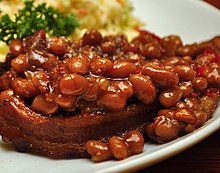
New England cuisine is an American cuisine which originated in the New England region of the United States, and traces its roots to traditional English cuisine and Native American cuisine of the Abenaki, Narragansett, Niantic, Wabanaki, Wampanoag, and other native peoples. It also includes influences from Irish, French-Canadian, Italian, and Portuguese cuisine, among others. It is characterized by extensive use of potatoes, beans, dairy products and seafood, resulting from its historical reliance on its seaports and fishing industry. Corn, the major crop historically grown by Native American tribes in New England, continues to be grown in all New England states, primarily as sweet corn although flint corn is grown as well. It is traditionally used in hasty puddings, cornbreads and corn chowders.

The cuisine of the Southern United States encompasses diverse food traditions of several subregions, including Tidewater, Appalachian, Ozarks, Lowcountry, Cajun, Creole, African American Cuisine and Floribbean cuisine. In recent history, elements of Southern cuisine have spread to other parts of the United States, influencing other types of American cuisine.

Louisiana Creole cuisine is a style of cooking originating in Louisiana, United States, which blends West African, French, Spanish, and Native American influences, as well as influences from the general cuisine of the Southern United States.

Fabada asturiana, often simply known as fabada, is a rich Asturian bean stew, originally from and most commonly found in the autonomous community of Principality of Asturias, but widely available throughout the whole of Spain and in Spanish restaurants worldwide. Canned fabada is sold in most supermarkets across the country.
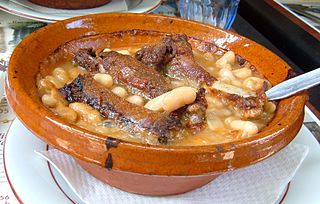
Cassoulet is a rich, slow-cooked stew originating in southern France. The food writer Elizabeth David described it as "that sumptuous amalgamation of haricot beans, sausage, pork, mutton and preserved goose, aromatically spiced with garlic and herbs". It originated in the town of Castelnaudary in the Aude department in the Occitanie region. Variants of the dish are local to other towns and cities in the Aude.

A casserole is a kind of large, deep pan or bowl used for cooking a variety of dishes in the oven; it is also a category of foods cooked in such a vessel. To distinguish the two uses, the pan can be called a "casserole dish" or "casserole pan", whereas the food is simply "a casserole". The same pan is often used both for cooking and for serving.

Tourtière is a French Canadian meat pie dish originating from the province of Quebec, usually made with minced pork, veal or beef and potatoes. Wild game is sometimes used. It is a traditional part of the Christmas réveillon and New Year's Eve meal in Quebec. It is also popular in New Brunswick, and is sold in grocery stores across the rest of Canada all year long. It gets its name from the tourte, which is what it was originally made from. Though the name "tourtière" is derived from its filling, the tourte—the French name for the passenger pigeon that is now extinct in North America—was historically used as its filling before the 20th century.
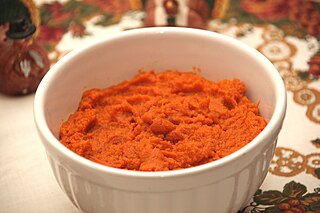
Mashed pumpkin is a vegetable dish made by cooking or macerating the skinless flesh (pulp) of pumpkins and then mashing, straining, grinding, or puréeing until the desired consistency is achieved. It is traditionally served as a side dish, although it has many uses in cooking and baking.

Clay pot cooking is a process of cooking food in a pot made of unglazed or glazed pottery.
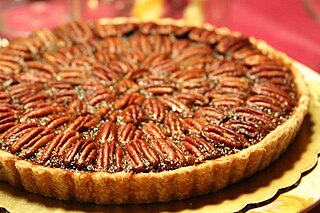
Pecan pie is a pie of pecan nuts mixed with a filling of eggs, butter and sugar. Variations may include white or brown sugar, cane syrup, sugar syrup, molasses, maple syrup, or honey. It is commonly served at holiday meals in the United States and is considered a specialty of Southern U.S. origin. Most pecan pie recipes include salt and vanilla as flavorings. Pecan pie may be served with whipped cream, vanilla ice cream or hard sauce.
Soup beans is a term common in the Southern United States, particularly the regions around the Appalachian Mountains. Soup beans are usually served with cornbread, greens, and potatoes and may be topped with raw chopped onions or ramps. Soup beans are considered a main course, but also serve as a side dish. In rural areas, where food was scarce during the winter, these dried beans were a staple food.

Pork and beans is a culinary dish that uses pork and beans as its main ingredients. Numerous variations exist, usually with more specific names, such as fabada asturiana, olla podrida, or American canned pork and beans.
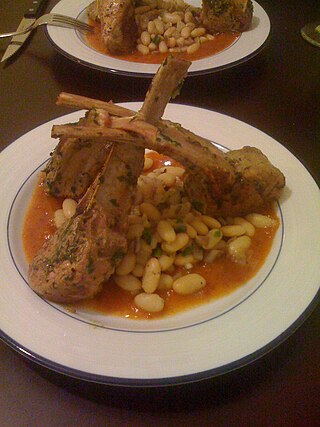
Cowboy beans is a bean dish popular in the southwestern United States. The dish consists of pinto beans and ground beef in a sweet and tangy sauce. Other types of meat can be used. The flavor is similar to baked beans but with a southwestern twist. Although cowboy appears in the name, the use of canned beans, ketchup, and barbecue sauce means the dish is unlike anything ranch hands would have eaten in the 19th century. Cowboy beans are served stewed or baked, depending on the recipe.

A ploye or ployes are a Brayon flatbread type mix of buckwheat flour, wheat flour, baking powder and water which is extremely popular in the Madawaska region in New Brunswick and Maine.

Boston baked beans are a variety of baked beans, sweetened with molasses, and flavored with salt pork or bacon.

The Maritimes consist of the provinces of New Brunswick, Nova Scotia and Prince Edward Island. Some of the cuisine has its origins in the foods of the indigenous peoples of the region.
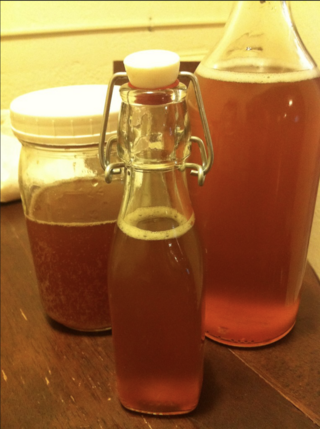
Cider syrup is also known as apple molasses. It is a fruit syrup concentrated from apple cider, first made in colonial America. It is a thick, dark brown, opaque syrup with concentrated apple flavor. The color is darker than honey and its flavor more tart than maple syrup. A syrup-like product has a much longer shelf-life than the fresh fruit, thereby extending the apple harvest's contribution to diets throughout the year.
Pie in American cuisine has roots in English cuisine and has evolved over centuries to adapt to American cultural tastes and ingredients. The creation of flaky pie crust shortened with lard is credited to American innovation.


